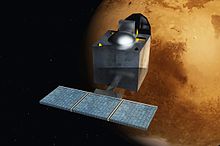
A lander is a spacecraft that descends towards, then comes to rest on the surface of an astronomical body other than Earth. In contrast to an impact probe, which makes a hard landing that damages or destroys the probe upon reaching the surface, a lander makes a soft landing after which the probe remains functional.

A Mars rover is a remote-controlled motor vehicle designed to travel on the surface of Mars. Rovers have several advantages over stationary landers: they examine more territory, they can be directed to interesting features, they can place themselves in sunny positions to weather winter months, and they can advance the knowledge of how to perform very remote robotic vehicle control. They serve a different purpose than orbital spacecraft like Mars Reconnaissance Orbiter. A more recent development is the Mars helicopter.

The planet Mars has been explored remotely by spacecraft. Probes sent from Earth, beginning in the late 20th century, have yielded a large increase in knowledge about the Martian system, focused primarily on understanding its geology and habitability potential. Engineering interplanetary journeys is complicated and the exploration of Mars has experienced a high failure rate, especially the early attempts. Roughly sixty percent of all spacecraft destined for Mars failed before completing their missions, with some failing before their observations could even begin. Some missions have been met with unexpected success, such as the twin Mars Exploration Rovers, Spirit and Opportunity, which operated for years beyond their specification.

The Indian Space Research Organisation is the national space agency of India. It operates as the primary research and development arm of the Department of Space (DoS), which is directly overseen by the Prime Minister of India while the Chairman of ISRO also acts as the executive of DoS. ISRO is primarily responsible for performing tasks related to space-based operations, space exploration, international space cooperation and the development of related technologies. ISRO is one of the six government space agencies in the world that possesses full launch capabilities, can deploy cryogenic engines, can launch extraterrestrial missions and operate a large fleet of artificial satellites. ISRO is one of the four government space agencies to have soft landing (unmanned) capabilities.

Chandrayaan-1 was the first Indian lunar probe under the Chandrayaan programme. It was launched by the Indian Space Research Organisation (ISRO) in October 2008, and operated until August 2009. The mission included an orbiter and an impactor. India launched the spacecraft using a PSLV-XL rocket on 22 October 2008 at 00:52 UTC from Satish Dhawan Space Centre, at Sriharikota, Andhra Pradesh. The mission was a major boost to India's space program, as India researched and developed indigenous technology to explore the Moon. The vehicle was inserted into lunar orbit on 8 November 2008.

Mylswamy Annadurai, popularly known as the Moon Man of India, is an Indian scientist working as vice president for Tamil Nadu State Council for Science and Technology, Chairman, Board of Governors, National Design and Research Forum. He was born on 2 July 1958, in Kothavadi in the Coimbatore district, Tamil Nadu state of India. Prior to taking this assignment he was with Indian Space Research Organisation and served as director of the Indian Space Research Organisation Satellite Centre. During his 36 years of service in the Indian Space Research Organisation, he had some of the major contributions, including two of the major missions of ISRO, namely Chandrayaan-1 and Mangalyaan. Annadurai has been listed among 100 Global thinkers of 2014 and topped the innovators list. His works are mentioned in textbooks of Tamil Nadu Board of Secondary Education
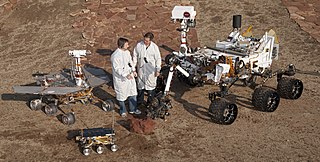
A rover is a planetary surface exploration device designed to move over the rough surface of a planet or other planetary mass celestial bodies. Some rovers have been designed as land vehicles to transport members of a human spaceflight crew; others have been partially or fully autonomous robots. Rovers are typically created to land on another planet via a lander-style spacecraft, tasked to collect information about the terrain, and to take crust samples such as dust, soil, rocks, and even liquids. They are essential tools in space exploration.

Chandrayaan-2 is the second lunar exploration mission developed by the Indian Space Research Organisation (ISRO) after Chandrayaan-1. It consists of a lunar orbiter, the Vikram lunar lander, and the Pragyan rover, all of which were developed in India. The main scientific objective is to map and study the variations in lunar surface composition, as well as the location and abundance of lunar water.
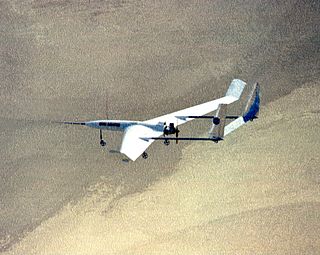
A Mars aircraft is a vehicle capable of sustaining powered flight in the atmosphere of Mars. So far, the Mars helicopter Ingenuity is the only aircraft ever to fly on Mars, completing 72 successful flights covering 17.242 km (10.714 mi) in 2 hours, 8 minutes and 48 seconds of flight time. Ingenuity operated on Mars for 1042 sols, until its rotor blades, possibly all four, were damaged, causing NASA to retire the craft.

The Mars Orbiter Mission (MOM), unofficially known as Mangalyaan, was a space probe orbiting Mars since 24 September 2014. It was launched on 5 November 2013 by the Indian Space Research Organisation (ISRO). It was India's first interplanetary mission and it made ISRO the fourth space agency to achieve Mars orbit, after Roscosmos, NASA, and the European Space Agency. It made India the first Asian nation to reach the Martian orbit and the first nation in the world to do so on its maiden attempt.
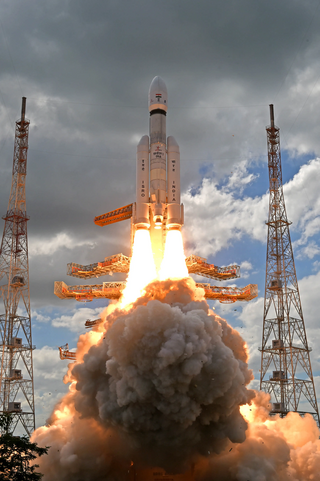
The Chandrayaan programme also known as the Indian Lunar Exploration Programme is an ongoing series of outer space missions by the Indian Space Research Organization (ISRO) for the exploration of the Moon. The program incorporates a lunar orbiter, an impactor, a soft lander and a rover spacecraft.
Mars Orbiter Mission 2, is a proposed second mission to Mars by the Indian Space Research Organisation (ISRO). In a recorded interview in October 2019, the Vikram Sarabhai Space Centre (VSSC) director indicated the possibility of inclusion of a lander, but in an interview to The Times Of India in February 2021 the ISRO chairman clarified that the mission will consist solely of an orbiter. The orbiter will use aerobraking to lower its initial apoapsis and enter into an orbit more suitable for observations.
Minal Rohit is an Indian scientist and systems engineer with the Indian Space Research Organisation (ISRO). She helped send the Mangalyaan space probe to Mars.
Moumita Dutta is an Indian Physicist working at the Space Applications Centre (SAC), Indian Space Research Organisation (ISRO) - Ahmedabad, as a scientist/engineer. She has expertise in the development and testing of the Optical and IR sensors/instruments/payloads. She was part of the team Mars Orbiter Mission (MOM) to put a probe into orbit around Mars in 2014. She contributed significantly in the development of one of the five payloads of MOM.

Pragyan is a lunar rover that forms part of Chandrayaan-3, a lunar mission developed by the Indian Space Research Organisation (ISRO).
The Lunar Polar Exploration Mission (LUPEX) is a planned joint lunar mission by the Indian Space Research Organisation (ISRO) and Japan Aerospace Exploration Agency (JAXA). The mission would send an uncrewed lunar lander and rover to explore the south pole region of the Moon no earlier than 2026. It is envisaged to explore the permanently shadowed regions on the Moon. JAXA is likely to provide the H3 launch vehicle and the rover, while ISRO would be providing the lander.
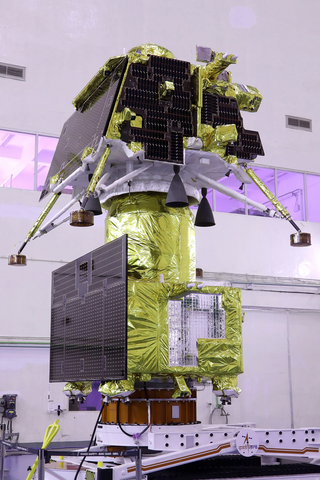
Chandrayaan-3 is the third mission in the Chandrayaan programme, a series of lunar-exploration missions developed by the Indian Space Research Organisation (ISRO). The mission consists of a Vikram lunar lander and a Pragyan lunar rover similar to those launched aboard Chandrayaan-2 in 2019, as well as a propulsion module that carried the spacecraft from Earth orbit to lunar orbit.
The Venus Orbiter Mission, unofficially known as Shukrayaan, is a planned Indian Space Research Organisation (ISRO) mission to study the surface and atmosphere of Venus.



